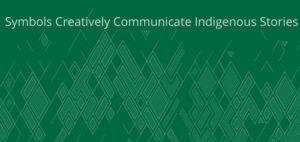Symbols Creatively Communicate Indigenous Stories
Posted on Thursday, September 2nd, 2021
When the DARE district opened in 2018, Ryan Gorrie, a Bingwi Neyaashi Anishinābek architect, worked to incorporate Indigenous symbols reflective of Anishinābe culture and traditions.
A series of hieroglyphic-style symbols was created for design purposes. Since then, those symbols have been more widely incorporated throughout the college online, on murals and building walls, and in its marketing materials, including most recently in the 2020 Annual Report.
“The college made significant commitments about inclusion and we found it really important to work with Ryan Gorrie,” said Ron (Deganadus) McLester, Vice President – Truth, Reconciliation & Indigenization. The work we do honours the host nation (the territory of the Anishinābe people) and the diversity of our Indigenous students.”
The clean and simple line drawing of animals, in particular, have significance in many stories. “The animals are based on some of the teachings we were given and they are important, including different animals like the bear and turtle,” said Andre O’Bonsawin, Director of Indigenous Initiatives.
Symbols include the seven original clans of the Anishinābe: crane, marten, bird, fish, bear, loon and deer, and the Seven Grandfather teachings: courage, humility, truth, respect, love, honesty and wisdom.
Usage guidelines were created to ensure symbols were used correctly and respectfully.
McLester also had a unique and creative approach to adding design to spaces. “Instead of securing and procuring (art), what if we procure our own”, he asked? “During that work, we started thinking about using glass to display culture and art and stay within the guidelines. Etching into the glass would be permanent and the shadows and light would change.”
Careful thought and consideration was given to include meaningful images. “The birch tree is important to Anishinābe culture and that image is there,” said McLester.
Another significant design feature is the absence of a plaque explaining the imagery. That was thoughtful and intentional. “If you put plaque in English on the wall you are losing the oral stories,” said McLester. “Through events and sharing stories other people will know them too. Algonquin College has committed to embedding these stories into the fabric of the organization and you can only do that by creating culture.”
The unique iconography will continue to be used, seen and shared. Information about the images is be available on the recently created TRI webpage.
Samples of the design symbols will be available to view, as well as guidelines as to how they are to be used and shared. View the guide here.
On September 30, Canada will mark its first National Day for Truth and Reconciliation. To mark the event, Algonquin College is running a month-long series of stories examining different aspects of its own Truth, Reconciliation and Indigenization. Learn more at https://www.algonquincollege.com/tri
- Posted in
- TRI News